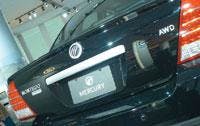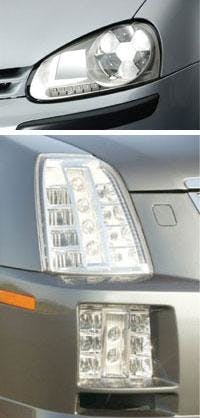ROBERT V. STEELE
Light-emitting diodes (LEDs) have had a reasonably successful history in penetrating the automotive lighting market over the past 20 years. While conventional LEDs have long been used for various indicator-lamp functions inside the car, it was the advent of high-brightness (HB) LED technology in the late 1980s and early 1990s that enabled the use of LEDs for exterior signaling functions. The first significant use of HB LEDs in an automotive signaling application was in the center high-mounted stop lamp on the 1988 Nissan 280Z. The LED-based stop lamp was manufactured by Stanley Electric (Tokyo, Japan), using an array of 72 aluminum gallium arsenide (AlGaAs) red LEDs.
With the development of more-robust indium gallium aluminum phosphide (InGaAlP) HB LED technology by Toshiba and Hewlett-Packard in the early 1990s, the automotive-signaling market began a period of substantial growth. By 2004, approximately 40% of all automobiles and light trucks produced worldwide featured LED-based center high-mounted stop lamps. This market has been driven by a combination of the higher performance (for example, shorter turn-on times), higher reliability, and more-flexible styling possibilities offered by LEDs as compared to the standard incandescent-lamp alternative. Steadily declining HB LED prices have helped to propel the market as well.
Beyond the luxury market
As a result of the successful history of use of HB LEDs in center high-mounted stop lamps, these devices began to be adopted in other signaling functions in the late 1990s-most notably in rear-stop, turn, and taillamp assemblies. Primarily because of cost issues, the use of HB LEDs in such functions has been limited primarily to high-end luxury cars, with worldwide penetration in 2004 at slightly less than 4%. This situation is starting to change, however, as several mid-range car models adopted LED-based rear-stop, turn, or taillights in 2004. One example is the 2005 Mercury Montego sedan (see Fig. 1).
FIGURE 1. The 2005 Mercury Montego, a mid-range car, is fitted with LED taillights.
A historic development for the LED and automotive industries was the announcement in early 2004 of the first use of LEDs in the front end of a car. The 2004 Audi A8 6.0L (a $120,000 luxury vehicle) used six 1-W white Luxeon LEDs (manufactured by Lumileds Lighting of San Jose, CA) in its daytime-running-lamp assembly. White LEDs use blue gallium nitride (GaN)-based LED chips in combination with a yellow phosphor in the same package to produce a white-appearing spectrum. Additional use of white LEDs in daytime running lamps and fog lamps on other car models is expected over the next several years.
In addition to exterior signaling functions, HB LEDs have had considerable success in the automobile interior-lighting market for instrument-panel lighting. The use of HB LEDs in this application has surpassed 80% penetration of the cars produced in Europe, and is growing rapidly in Japan and the United States. In total, the market for HB LEDs used in all automotive-lighting applications (exterior plus interior) in 2004 was nearly $500 million. There remains one application that LEDs have as yet been unable to penetrate, however, and this has the potential of being the largest market of all.
Targeting forward lighting
Despite the successes to date, HB LEDs have not yet been able to penetrate the market for forward lighting (headlamps). Until recently, this application was considered highly problematic because of the low lumen output and efficiency of commercially available white LEDs. The forward-lighting market seems finally within reach, however, with the development in the past few years of high-power white LEDs using large-area (1 × 1-mm) gallium nitride (GaN) chips and sophisticated packaging techniques, and ongoing improvements in efficiency. In addition to LED efficiency and lumen output, other engineering challenges include thermal-management issues arising from the fact that the headlamp enclosure is within the engine compartment, which is at elevated temperatures; and development of a suitable optical system for providing the precise lighting patterns required by automotive-standards regulators.
Forward lighting for automobiles is primarily a safety issue. Various standards have been developed to ensure that headlamp performance provides an adequate margin of safety for nighttime driving. The two major international standards that govern headlamp performance are the European E-Code (ECE), used in Europe and Japan, and the Federal Motor Vehicle Satety Standard (FMVSS) in the United States. Both standards were recently revised (2003) to address new forward-lighting technologies, such as adaptive front-light systems. The Society for Automotive Engineers (SAE) Lighting Standards Committee also develops standards for automotive lighting, based on the industry’s best practice. A draft standard for LED forward lighting (J2650-LED Road Illumination Devices) has been developed by the SAE Lighting Standards Committee and is under consideration for final approval.
For LED forward lighting, one of the key challenges is luminance, measured in candelas per square meter (cd/m2). Headlamp standards call not only for a certain number of lumens in a defined pattern on the road, but also have intensity requirements in “hot spots,” measured in candelas. Typical tungsten-halogen lamps used in automobile headlamps generate 1000 lumens of white light. That requirement can be met with LEDs just by using an assembly of enough high-power white LEDs to produce 1000 lumens, but meeting the luminance requirement has been a more difficult challenge.
Driving factors
The use of LEDs in forward lighting appears to be driven mainly by issues of styling and customer appeal, although lifetime and power efficiency are also important considerations. The use of LEDs in headlamps would allow automobile designers to develop configurations that are not possible with standard halogen or high-intensity discharge (HID) lamps, and many new designs have been shown in concept cars. Most of the major “tier one” automotive lighting suppliers around the world, working in conjunction with auto manufacturers, have LED headlamp programs. These programs are not directed toward near-term applications, but rather toward production platforms several years in the future. The consensus in the industry seems to be that 2007 will be the earliest year that LED headlamps will appear in a production automobile.
The emergence of LED headlamps is taking place in an environment in which automotive forward-lighting technology has been undergoing considerable change. For example, xenon-based HID lamps were introduced in the late 1990s, and were used in an estimated six million new cars sold in 2004. Although much more expensive than standard halogen lamps, they offer a number of benefits, including lower power consumption, higher lumen output, and longer lifetime. In 2003, adaptive front-light systems were introduced to the market. The primary advantage of these systems is that they allow the headlamps to “see” around corners, thus substantially improving nighttime driving safety. These examples show that automotive lighting technology is far from static and that changes can be implemented, even if higher in cost than conventional technology, if substantial benefits can be demonstrated.
LED headlamp prototypes
In the first quarter of 2005, three major automotive-lighting companies announced LED-based headlamps that would be ready for adoption into production automobiles in the next few years: Stanley Electric, Visteon (Van Buren Township, MI), and Hella KGaA Hueck & Co. (Lippstadt, Germany).
Stanley announced that it would start producing white LED-based headlamps in 2007, although it has not released much detail about the design or performance of the headlamps. It stated that its production capacity would be sufficient to supply 5000 vehicles per month in 2007. These are expected to be high-end luxury cars. By 2010 Stanley expects its capacity to reach 600,000 vehicles per month.
FIGURE 2. The light output of an LED headlamp prototype developed by Hella KGaA Hueck & Co. (top) matches the output from a xenon high-intensity-discharge headlamp. Visteon's LED headlamp assembly for the Cadillac STS meets U.S. federal requirements for automotive front lighting (bottom).
Hella and Visteon both showed prototypes of their LED headlamps at the SAE World Congress in mid-April (see Fig. 2). Hella has developed a prototype headlamp assembly for the Volkswagen Golf 5. The assembly incorporates high-beam and low-beam headlamps, as well as vehicle sidemarkers and a daytime running lamp. Hella’s LED headlamp achieves a level of about 1000 lumens in the low beam, and matches the light output of a xenon lamp. This is achieved using just four segments of the seven-segment lens system. All seven segments are used for the high beam. Hella’s headlamps meet SAE standards for forward lighting in the United States, and will meet ECE regulations in Europe by 2008.
Visteon’s LED headlamp assembly was designed for the Cadillac STS. The company states that this assembly uses unique optics and a new method of light-source placement to produce a beam pattern that meets U.S. federal requirements for automotive front lighting, and the company says it is capable of bringing this technology to the automotive market in a matter of months. Advantages claimed for Visteon’s LED headlamps include flexibility in design, improved packaging, reduced power consumption, and long life.
Based on these developments, it appears that the era of LED-based forward lighting is fast approaching. While engineering challenges remain, they are quickly being solved, and we can expect to see an increasing number of cars on the road with LED headlamps in 2007 and beyond. This application will be one of the most promising new markets for HB LEDs in the second half of this decade, and will be a strong component of an expected $1 billion market for HB LEDs in automotive lighting in 2009.❏
ROBERT V. STEELE is director of optoelectronic programs at Strategies Unlimited, 201 San Antonio Circle, Suite 205, Mountain View, CA 94040; e-mail: [email protected]; www.strategies-u.com.

